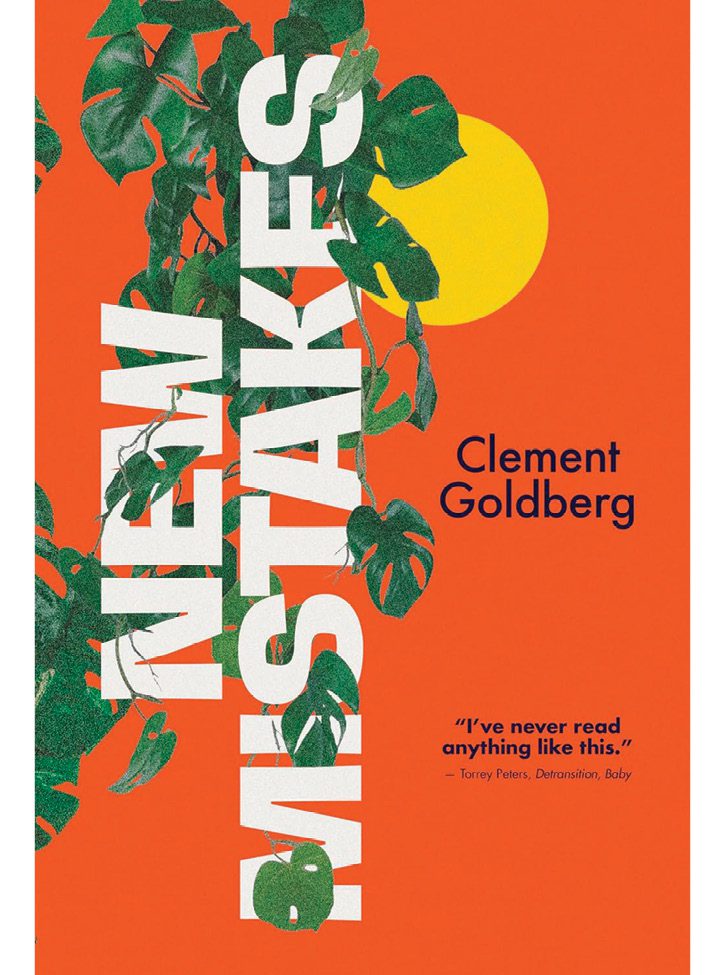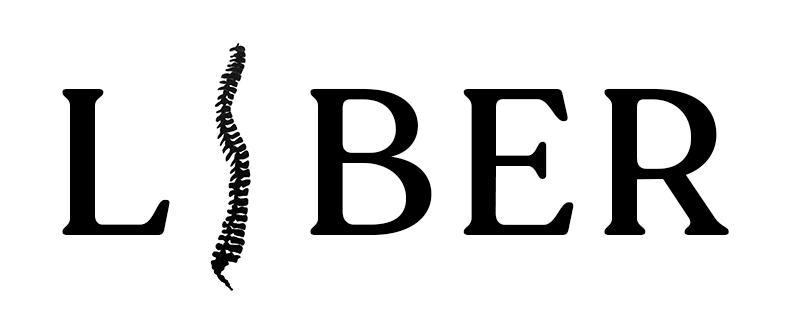
From the first paragraph, multidisciplinary artist and animator Clement Goldberg’s debut novel New Mistakes telegraphs to the reader that they can and should throw out everything they expect from conventional narrative fiction and instead just flow with this weird and wicked ride for the next two-hundred-something pages. Those familiar with Goldberg’s short stop-motion animated films already have their pumps primed for the unexpected, funny, anthropomorphic, psychedelic, and tender turns the book will take. This novel is an exciting continuation of the artist’s exploration of climate crisis and social satire through the twinned apertures of hope and grief.
New Mistakes chronicles the antics of a handful of characters whose fates become intertwined, but not quite for the reasons they expect. The characters try to live through emotional throat punches to their selfhoods, muck through shin-deep relational and professional failures, and strive to get laid despite the lurid banality of their sexual desires, backdropped in the simulacrum called California, an outsize blip of the cultural imaginary existing on a planet set to boil by the death-drive machinations of cynical late-stage capitalist America. The characters try to make art or at least something moderately beautiful, longing to find meaning and connection as they stumble toward purpose.
Julia is a young woman with artistic proclivities and a biological imperative to have as much fun as possible before she turns thirty. The novel opens with Julia being ejected from her relationship with her girlfriend due to mission creep in their newfound throuplehood. She shows up a month late to house-sit for her half-brother Franklin, a trans novelist riding a wave of success and away at a prestigious writing fellowship. Julia rolls into her brother’s home only to discover she is responsible for a near-complete massacre of Franklin’s large collection of houseplants. Surviving plants have no plans to shield Julia from her culpability in their demise. Just as the plants begin to communicate with Julia, interspecies communication transmits to other people, all of whom seem on the verge of spiraling toward the nadir of their own current circumstances. Cats begin to communicate with humans, most prominently a social media influencer and cat psychic named Henry, who is being topped from the bottom by Edith, a tuxedo cat with high emotional IQ. Edith grows impatient with her human’s sluggish response to the evolutionary upgrade in consciousness with which he has been gifted. Meanwhile Avery—a recently unemployed adjunct women and gender studies professor and only son of Evil Fated, a famous leatherdyke photographer—is visited by glowing orbs that swoop over his mother’s cul-de-sac in geometric formations seemingly directed by his thoughts.
Queer sluts and gangs of cat-psychic teenagers join forces to shepherd in a new era and save the world.
The people who find themselves in conversation with cats, plants, or glowing UAPs must fight the pressure of normative society that would codify them as crazy and instead tune into and embrace their unique abilities as antennae. For once in their lives, they have an opportunity to reframe the sensitivity they’ve long been maligned for and to accept the invitation to speak with beings that possess the technology—and ethics—to save the planet. One plant communicator claims that “extraterrestrials have technology that would improve all our lives. It would shift the power structures in place and have a profoundly beneficial impact for most of the population. The wealthiest people do not want things to fundamentally change . . . so they fund the politicians, put people in the most important places.” As those in power wish to maintain a status quo that so obviously benefits themselves, extraterrestrial intelligence finds other, subversive ways to initiate contact with humans. Queer sluts and gangs of cat-psychic teenagers join forces to shepherd in a new era and save the world.
Goldberg’s prose is hilariously cutting and lascivious. The author captures an entire vibe in a single zinging line or tungsten-sharp image. Readers might laugh their asses off at the author’s satirical snapshots of the characters’ naked ambitions long left macerating in a cocktail of insecurity, lust, and ego, but Goldberg doesn’t let us laugh too long before turning the spotlight back onto the vulnerable humanity driving the story. Avery, pining over his ex-girlfriend, recalls the point in their disintegrating relationship when she had stopped filtering at him and spoke at length about her erotic fantasies of a hot guy working at a falafel shop:
Avery asked if she ever thought of the falafel guy while they were intimate.
“How can I? You consistently interrupt my inner life with a cloying need for me to be present when we fuck.”
He assumed she was joking, a bit more acerbic than her usual wit, but still. He loved her and thought they would be married someday.
At times I even felt delightfully trolled while reading, because the characters are both parody and mirror of any of us trying to figure out how to make it through this current moment.
As events unfold, narration presenting itself as limited third person starts to morph into a preternatural voice, a kind of outsize meta-omniscience that taps into the basest, most unfiltered thoughts and feelings of each character. A strange narrative style emerges, one closer to telepathy than to storytelling. POV shifts whiplash between paragraphs and sometimes even between sentences, a methodology that would likely be excoriated as “head hopping” and workshopped out of existence from early drafts in an MFA classroom. For example, in this scene, Avery, who has moved back in with his mother, is confronted by Evil’s girlfriend, Catherine:
Catherine looked at Avery and asked if he had a rando in the house, someone from an app? Avery played stupid. He wanted to will her question away. It was not personal. He did not mean to be a dick. Catherine pointed at the two wine glasses, evidence that he was full of shit and that he knew what she was asking. The vague exchange angered Evil. She demanded that he answer Catherine’s simple question. Avery nodded his head and said, “Umm hmm,” like an eight-year-old girl hiding a stolen, half-eaten candy bar. Catherine was embarrassed for him but also upset.
Lucky for us, Goldberg eschews received wisdom about narrative structure and instead invents something wonderful that communicates collectively on a more mycelial level. The book is not only teaching us how to read it but also inculcating the reader toward the book’s larger mission—that to survive this present moment, we humans must decenter ourselves and listen to the multiple forces, human and non-, imploring us to tune into our interdependence with the other living things of this world.
Delicious queer art and pop culture references populate New Mistakes and reinforce the comedy. Patti Smith’s pet cats become larger-than-life characters in Franklin’s writing. Keith Haring’s early images of hovering UFOs beaming electric bolts down onto people and dogs presage Avery’s experience communicating psychically with the orbs. Evil lets herself go wild at an Ecosexual art-project-meets-sex-party, regaining fire for her creative process, and even the rallying cry of the Industrial Workers of the World—Direct Action Gets the Goods—makes an affirming appearance while connecting threads between modes of direct action old and new.
The climax of New Mistakes leaves some uncertainty. Will the stand taken at the end by hot, horny, and ambitious Julia and Mistake, a young art-world darling and universally recognized tasty treat, further the movement of psychic cats and teen cat psychics, thus making way for intelligent life to thwart the barrier of Earth’s unintelligent life? Or will the consummation of their lust shift their priorities toward ego-fluffing pursuits instead? A delightful third possibility: perhaps here lies an open-endedness reaching tendrils out toward a sequel.
Toward the very end of the book, “Bathysphere,” a Bill Callahan song covered by Chan Marshall, a.k.a. Cat Power, makes a moving cameo. Context: In the summer of 1930, the naturalist William Beebe and engineer Otis Barton descended to ocean depths farther than any human had previously in a vessel called the bathysphere, which Barton designed. Beebe was the first human to behold the vanishing frequencies of sunlight through the sea. As the bathysphere plummeted down, eventually the only colors of sunlight visible were shades of blue and violet, an aquatic trans flag. The song signals the healing of a childhood wound inflicted on Franklin by a parent around his most capacious dreams. The song also serves as portent: to thrive as an artist, Franklin must surface the bathysphere of his isolation and reconnect with community. And perhaps Beebe’s discovery echoes a key concern of New Mistakes. The only way we can expand our visible palette of colors is to pull up out of our individualistic, isolated depths and find each other in the light.

